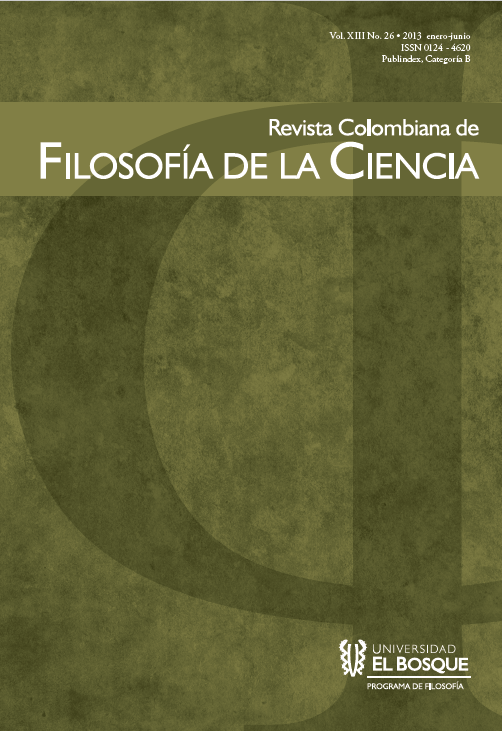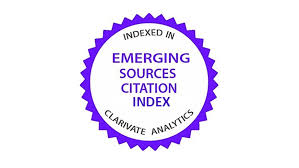¿Acerca de qué nos habla la química? Nuevos argumentos en favor de la autonomía ontológica del mundo químico
DOI:
https://doi.org/10.18270/rcfc.v13i26.1645Resumen
Si bien la química como disciplina tiene una larguísima historia, los impresionantes
éxitos de la mecánica cuántica en el siglo XX han conducido a concebirla como una
rama de la física sobre la base de un enfoque netamente reduccionista. El propósito del
presente trabajo consiste en abordar el tema de la relación entre química y física tal como
ha sido discutido en la reciente filosofía de la química. El objetivo final, en sintonía con
artículos previos, es defender la autonomía ontológica del mundo químico desde una
perspectiva anti-reduccionista, tomando en consideración ciertas críticas directas a tales
trabajos formuladas durante los últimos años.
Descargas
Referencias bibliográficas
Amann, A. “Must a molecule have a shape?”. South African Journal of Chemistry
(1992): 29-38.
Baird, D., Scerri, E. & McIntyre, L., Eds. Philosophy of Chemistry: Synthesis of
a New Discipline. Dordrecht: Springer, 2006. Boston Studies in the Philosophy
of Science 242.
Benfey, T. “Reflections on the philosophy of chemistry and a rallying call for
our discipline”. Foundations of Chemistry 2 (2000): 195-205.
Bishop, R. & Atmanspacher, H. “Contextual emergence in the description of
properties”. Foundations of Physics 36 (2006): 1753-1777.
Castagnino, M. & Lombardi, O. “Self-induced decoherence: A new approach”.
Studies in History and Philosophy of Modern Physics 35 (2004): 73-107.
Cat, J. “The unity of science”. The Stanford Encyclopedia of Philosophy. Ed. E.
N. Zalta. 2007. <http://plato.stanford.edu/archives/fall2010/entries/scientific-
unity/>.
Chamizo, J. A. “The public image of chemistry”. Educacion Química 22
(2011): 320-331.
Daintith, J. Dictionary of Chemistry. Oxford: Oxford University Press, 2004.
Dirac, P. A. M. “Quantum mechanics of many-electron systems”. Proceedings
of the Royal Society A338 (1929): 714-733.
Emerson, K. “The quantum mechanical explanation of the periodic system”.
Journal of Chemical Education 76 (1999): 1189.
Einstein, A., Podolsky, B. & Rosen, N. “Can quantum-mechanical description
of physical reality be considered complete?”. Physical Review 47 (1935):
-780.
Estany, A. “¿Es posible una filosofía de la química?”. Investigación y Ciencia
(2011 septiembre): 52-53.
French, S. & Krause, D. Identity in Physics: A Historical, Philosophical and
Formal Analysis. Oxford: Oxford University Press, 2006.
Hacking, I. Representing and Intervening. Cambridge: Cambridge University
Press, 1983.
Hawkes, S. J. “Unsaturated bonds should not be represented in introductory
chemistry by orbital overlap”. Chemistry. Bulgarian Journal of Chemical
Education 16 (2007): 90-91.
Hendry, R. “Models and approximations in quantum chemistry”. Idealization
IX: Idealization in Contemporary Physics. Ed. N. Shanks. Amsterdam:
Rodopi, (1998): 123-42. Poznan Studies in the Philosophy of the Sciences
and the Humanities 63.
—. “Is there downwards causation in chemistry?”. Philosophy of chemistry:
synthesis of a new discipline. Berlin: Springer (2006): 173-189.
—. “Ontological reduction and molecular structure”. Studies in History and
Philosophy of Modern Physics 41 (2010): 183-191.
Hettema, H. Reducing Chemistry to Physics: Limits, Models, Consequences.
Groningen: Rijksuniversiteit Groningen, 2012.
Hoffmann, R. “What might philosophy of science look like if chemists built
it?”. Synthese 155 (2007): 321-336.
Humphreys, C. J. “Electron seen in orbit”. Nature 401 (1999): 49-52.
Itatani, J., Levesque, J., Zeidler, D., Niikura, H., Pépin, H., Kieffer, J. C.,
Corkum, P. B. & Villeneuve, D. M. “Tomographic imaging of molecular
orbitals”. Nature 432 (2004): 867-871.
Jacoby, M. “Picture-perfect orbitals”. Chemical & Engineering News 77 (1999): 8.
Kemeny, J. G. & Oppenheim, P. “On reduction”. Philosophical Studies 7
(1956): 6-19.
Kochen, S. & Specker, E. “The problem of hidden variables in quantum
mechanics”. Journal of Mathematics and Mechanics 17 (1967): 59-87.
Koolage, W. J. & Hall, R. “Chemical action: what is it, and why does it really
matter?”. Journal of Nanoparticle Research 13 (2011): 1401-1417.
Labarca, M. & Lombardi, O. “Irreversibilidad y pluralismo ontológico”.
Scientiae Studia 5 (2007): 139-167.
—. “The end of the dream of unity”. Current Science 94 (2008): 438-439.
—. “Why orbitals do not exist?”. Foundations of Chemistry 12 (2010): 149-157.
—. “On the autonomous existence of chemical entities”. Current Physical
Chemistry 1 (2011): 69-75.
Le Poidevin, R. “Missing elements and missing premises: A combinatorial
arguments for the ontological reduction of chemistry”. The British Journal
for the Philosophy of Science 56 (2005): 117-134.
Lombardi, O. “Determinism, internalism and objectivity”. Between Chance
and Choice: Interdisciplinary Perspectives on Determinism. Eds. H. Atmanspacher
& R. Bishop. Thorverton: Imprint-Academic, 2002.
Lombardi, O. & Labarca, M. “The ontological autonomy of the chemical
world”. Foundations of Chemistry 7 (2005): 125-148.
—. “The ontological autonomy of the chemical world: A response to
Needham”. Foundations of Chemistry 8 (2006): 81-92.
Lombardi, O. & Martínez González, J. C. “Entre mecánica cuántica y estructuras
químicas: ¿a qué refiere la química cuántica?”, Scientiae Studia 10
(2012): 649-670.
Lombardi, O. & Pérez Ransanz, A. R. “Lenguaje, ontología y relaciones
interteóricas: en favor de un genuino pluralismo ontológico”. Revista Arbor.
Ciencia, Pensamiento y Cultura 187 (2011): 43-52.
—. Los Múltiples Mundos de la Ciencia. Un Realismo Pluralista y su Aplicación
a la Filosofía de la Física. México: UNAM-Siglo XXI, 2012.
Luisi, P. L. “Emergence in chemistry: Chemistry as the embodiment of emergence”.
Foundations of Chemistry 4 (2002): 183-200.
Manafu, A. “Internal realism and the problem of ontological autonomy:
A critical note on Lombardi and Labarca”. Foundations of Chemistry 15
(2012): 225-228.
McIntyre, L. “The philosophy of chemistry: ten years later”. Synthese 155
(2007a): 291-292.
—. “Emergence and reduction in chemistry: ontological or epistemological
concepts?”. Synthese 155 (2007b): 337-343.
Mulder, P. “On the alleged non-existence of orbitals”. Studies in History and
Philosophy of Modern Physics 41 (2010): 178-182.
—. “Are orbitals observable?”. Hyle - International Journal for Philosophy of
Chemistry 17 (2011): 24-35.
Mulliken, R. S. Life of a Scientist. New York: Springer-Verlag, 1986.
Nagel, E. The Structure of Science. New York: Harcourt, Brace & World, 1961.
Needham, P. “Ontological reduction: A comment on Lombardi-Labarca”.
Foundations of Chemistry 8 (2006): 73-80.
—. “Nagel’s analysis of reduction: Comments in defense as well as critique”.
Studies in History and Philosophy of Modern Physics 41 (2010): 163-170.
Nelson, P. “How do electrons get across nodes?”. Journal of Chemical Education
(1990): 643-647.
Neurath, O. “Pseudorracionalismo de la falsación”. Redes 10 (2002): 87-118.
Trad. de “Pseudorationalism of falsification”. 1935. Philosophical Papers
-1946. Ed. R. Cohen y M. Neurath. Dordrecht: Reidel, 1983. 121-131.
Newman, M. “Chemical supervenience”. Foundations of Chemistry 10 (2008):
-62.
Nye, M. J. From Chemical Philosophy to Theoretical Chemistry - Dynamics of
Matter and Dynamics of Disciplines 1800-1950. Berkeley: University of
California Press, 1993.
Pagliaro, P. “On shapes, molecules and models: an insight into chemical
methodology”. European Journal of Chemistry 1 (2010): 276-281.
Pascual, J. I., Gómez-Herrero, J., Rogero, C., Baró, A. M., Sánchez-Portal,
D., Artacho, E., Ordejón, P. & Sovvler, J. M. “Seeing molecular orbitals”.
Chemical Physical Letters 321 (2000): 78-82.
Pérez Ransanz, A. R. Kuhn y el Cambio Científico. México: Fondo de Cultura
Economica, 1999.
Primas, H. Chemistry, Quantum Mechanics and Reductionism. Berlin: Springer,
—. “Hierarchic quantum descriptions and their associated ontologies”. Symposium
on the Foundations of Modern Physics 1994. Ed. K. V. Laurikainen, C.
Montonen y K. Sunnarborg. Gif-sur-Yvette: Editions Frontières, 1994.
—. “Emergence in exact natural sciences”. Acta Polytechnica Scandinavica 91
(1998): 83-98.
Putnam, H. Reason, Truth and History. Cambridge: Cambridge University
Press, 1981.
Richman, R. “In defense of quantum numbers”. Journal of Chemical Education
(1999a): 608.
—. “The use of one-electron quantum numbers to describe polyatomic
systems”. Foundations of Chemistry 1 (1999b): 175-83.
Rohrlich, F. “Pluralistic ontology and theory reduction in the physical
sciences”. The British Journal for the Philosophy of Science 39 (1988): 295-312.
Scerri, E. “The electronic configuration model, quantum mechanics and
reduction”. The British Journal for the Philosophy of Science 42 (1991): 309-25.
—. “Has chemistry been at least approximately reduced to quantum mechanics?”.
PSA 1994. Vol. 1. Eds. D. Hull, M. Forbes & R. Burian. East
Lansing: Philosophy of Science Association, 1994. 160-170.
—. “The periodic table and the electron”. American Scientist 85 (1997):
-553.
—. “The failure of reduction and how to resist disunity of the sciences in the
context of chemical education”. Science & Education 9 (2000a): 405-425.
—. “Realism, reduction and the ‘intermediate position’”. Of Minds and Molecules.
New Philosophical Perspectives on Chemistry. Eds. N. Bhushan & S.
Rosenfeld. New York: Oxford University Press, 2000b. 51-72.
—. “Have orbitals really been observed?”. Journal of Chemical Education 77
(2000c): 1492-1494.
—. “The recently claimed observation of atomic orbitals and some related
philosophical issues”. Philosophy of Science 68 (2001): S76-S88.
—. “Have orbitals really been observed? (author reply)”. Journal of Chemical
Education 79 (2002): 210.
—. “Just how ab initio is ab initio quantum chemistry?”. Foundations of
Chemistry 6 (2004): 93-116.
—. “Editorial 20”. Foundations of Chemistry 7 (2005a): 119-123.
—. “Some aspects of the metaphysics of chemistry and the nature of the
elements”, Hyle - International Journal for the Philosophy of Chemistry 11
(2005b): 127-145.
—. “Normative and descriptive philosophy of science and the role of
chemistry”. Baird, Scerri & McIntyre. 119-128.
—. “The ambiguity of reduction”. Hyle - International Journal for Philosophy
of Chemistry 13 (2007): 67-81.
—. “General introduction to the papers”. Collected Papers on Philosophy of
Chemistry. Londres: Imperial College Press, 2008a. 1-22.
—. “Philosophy of chemistry, reduction, emergence and chemical education”.
Advances in Teaching Physical Chemistry. Eds. M. Ellison & T. Schoolcraft.
Washington: American Chemical Society, 2008b. 59-72.
Scerri, E. & McIntyre, L. “The case for the philosophy of chemistry”. Synthese
(1997): 213-232.
Schuster, P. “‘Less is more’ and the art of modeling complex phenomena:
simplification may but need not be the key to handle large networks”.
Complexity 11 (2005): 11-13.
Schwarz, W. H. E. & Wang, S. G. “Some solved problems of the periodic
system of chemical elements”. International Journal of Quantum Chemistry
(2010): 1455-1465.
Sklar, L. Physics and Chance. Cambridge: Cambridge University Press, 1993.
Ströhle, A. “Molecularization in nutritional science: a view from philosophy
of science”. Molecular Nutrition & Food Research 54 (2010): 1385-1404.
Tinoco Jr. I., Sauer, K., Wang, J. C. y Puglisi, J. D. Physical Chemistry - Principles
and Applications in Biological Sciences. New Jersey: Prentice Hall,
Torretti, R. “El realismo científico y la ciencia como es”. Escritos Filosóficos
-2006. Santiago de Chile: Universidad Diego Portales, 2007. 75-98.
Trad. de “Scientific realism and scientific practice”. The Reality of the Unobservable:
Observability, Unobservability and their Impact on the Issue of Scientific Realism. Ed. E. Agazzi & M. Pauri. Dordrecht: Kluwer, 2000.
-122.
—. Manuel Kant. Santiago de Chile: Ediciones Universidad Diego Portales,
Van Brakel, J. “Chemistry as the science of the transformation of substances”.
Synthese 111 (1997): 253-282.
—. Philosophy of Chemistry. Between the Manifest and the Scientific Image.
Leuven: Leuven University Press, 2000a.
—. “The nature of chemical substances”. Of Minds and Molecules. New Philosophical
Perspectives on Chemistry. Eds. N. Bhushan & S. Rosenfeld. New
York: Oxford University Press, 2000b. 162-184.
Vancik, H. “Opus magnum: An outline for the philosophy of chemistry”.
Foundations of Chemistry 1 (1999): 242-256.
Vemulapalli, G. K. y Byerly, H. “Remnants of reductionism”. Foundations of
Chemistry 1 (1999): 17-41.
Vesterinen, V. M. & Aksela, M. “A novel course of chemistry as a scientific
discipline: how do prospective perceive nature of chemistry through visits
to research groups”. Chemistry Education Research and Practice 10 (2009):
-141.
—. “Quantitative analysis of representations of nature of science in nordic
upper secondary school textbooks using framework of analysis based on
philosophy of chemistry”. Science & Education 22 (2013): 1839-1855.
—. “Design of chemistry teacher education course on nature of science”.
Science & Education 22 (2013): 2193-2225.
Vihalemm, R. “The autonomy of chemistry: old and new problems”. Foundations
of Chemistry 12 (2010): 97-107.
Wang, S. G. & Schwarz, W. H. E. “On closed-shell interactions, polar covalences,
d shell holes, and direct images of orbitals: the case of Cuprite”.
Angewandte Chemie International Edition 39 (2000): 1757-1762.
—. “PSE - Icon of chemistry: The periodic system of chemical elements in the
new century”. Angewandte Chemie International Edition 48 (2009): 3404-3415.
Wasserman, E. & Schaefer, H. F. “Methylene geometry”. Science 233 (1986): 829.
Wilson, M. “John Earman’s A Primer on Determinism”. Philosophy of Science
(1989): 502-532.
Woolley, R. G. “Must a molecule have a shape?”. American Chemical Society
(1978): 1073-78.
—. “Natural optical activity and the molecular hypothesis”. Structure and
Bonding 52 (1982): 1-35.
Yam, P. “Seeing the bonds”. Scientific American 281 (1999): 28.
Zuo, J. M., Kim, M., O’Keefe, M. & Spence, J. C. H. “Direct observation of
d-orbital holes and Cu-Cu Bonding in Cu2O”. Nature 401 (1999): 49-52.
Zurer, P. “Chemistry’s top five achievements”. Chemical & Engineering News
(1999): 38-40.











